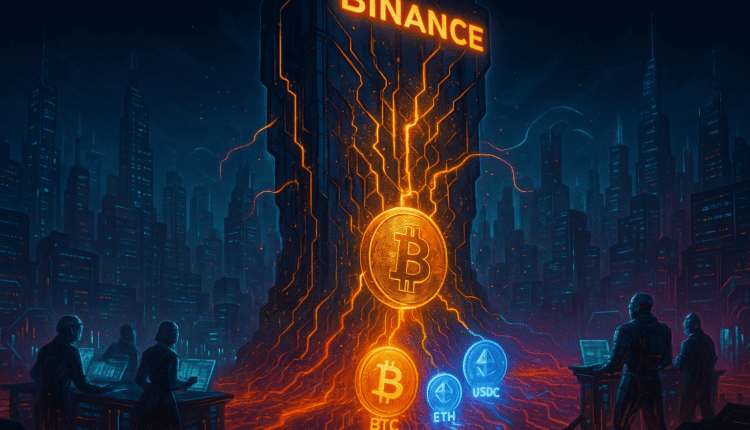Binance Exploit or Market Hack? How a Pricing Backdoor Crashed Altcoins Overnight

Altcoins didn’t just collapse — they were hacked. A hidden vulnerability inside Binance internal pricing system may have been exploited, triggering one of the most devastating liquidations in recent crypto history.
When Bitcoin and major altcoins plunged 70%–99% on Binance within minutes, traders blamed “macro panic.” But according to a viral video analysis circulating on X and YouTube, what really happened was a targeted exploit — a systemic backdoor in Binance’s internal price-calculation algorithm that allowed a coordinated market attack.
🧨 Not a Crash — a Controlled Detonation
Online advertising service 1lx.online
The sequence began when the USDE stablecoin, used widely as collateral on Binance’s “Unified Trading Account,” suddenly de-pegged — falling from $1.00 to $0.65 exclusively on Binance. On all other exchanges, USDE remained perfectly stable.
This localized collapse destroyed the valuation of traders’ collateral. Binance’s system, which calculated margin requirements using its own internal price feed rather than external market averages, immediately flagged tens of thousands of accounts as under-collateralized.
Within seconds, automatic liquidation bots sold off BTC, ETH, and top altcoins — creating a domino effect that erased billions in leveraged positions.
“It was like watching Terra Luna’s death spiral again — but this time, it started from inside the exchange,” one crypto analyst wrote on X.
⚙️ The Binance Pricing Backdoor
The alleged backdoor sat in plain sight — inside Binance’s collateral-valuation algorithm. Instead of referencing global market prices, Binance’s system valued user assets based on its own internal order books.
This meant that when manipulators pushed down the USDE price on Binance alone (by reportedly selling $60–90 million worth), the platform’s system believed those assets had genuinely lost value — even though, externally, they hadn’t.
One cybersecurity researcher compared it to a rigged appraisal:
“Imagine your bank decides how much your house is worth by asking its own realtor, not the market — and that realtor is working with thieves.”
Online advertising service 1lx.online
Between October 6–14, Binance had publicly scheduled an upgrade to migrate the valuation of USDE, WBETH, and BNSOL to external decentralized oracles. That announcement effectively gave hackers an eight-day window to exploit the old system — and they did.
💥 How the Attack Worked
- Preparation — Attackers accumulated USDE and other Binance-valued collateral assets.
- Short Setup — They opened massive BTC and ETH short positions (via HyperLiquid and other venues).
- Trigger — They dumped USDE on Binance, crashing its local price to $0.65.
- Cascade — Binance liquidated positions worth billions, driving Bitcoin and altcoin prices down globally.
- Profit — The attackers closed shorts at peak panic, reportedly earning around $200 million in minutes.
Simultaneously, a geopolitical distraction — Donald Trump’s tariff tweet and China’s retaliatory statement — conveniently drew attention away from the exploit. What appeared to be “macro-driven panic” may have been a perfectly timed cover story.
🧩 Binance’s Response
Online advertising service 1lx.online
Binance has not admitted to any “backdoor,” but sources inside the exchange confirmed an “unexpected issue” with the internal price feed for collateral assets. In a brief X post on October 11, Binance stated it had “identified an anomaly” and “implemented emergency re-valuation.”
“Some users affected by abnormal liquidations will receive compensation,” Binance Support posted.
Reports suggest compensation will target users who held USDE, WBETH, or BNSOL as collateral at the time. Screenshots of Chinese-language messages circulating on Weibo show early refund confirmations.
⚠️ Lessons & Structural Risks
This event exposes how fragile centralized pricing mechanisms can be — even in top-tier exchanges. A single internal pricing model, if misused or delayed in patching, can ripple across the global market.
The combination of Binance’s internal valuation, scheduled migration announcement, and external macro noise created a perfect storm: a technical flaw wrapped in plausible deniability.
Binance has promised “structural improvements” to its margin-calculation systems, but the trust damage may linger. Retail users are now questioning whether algorithmic transparency should become a regulatory requirement, not a feature.
Our creator. creates amazing NFT collections!
Support the editors - Bitcoin_Man (ETH) / Bitcoin_Man (TON)
Pi Network (Guide)is a new digital currency developed by Stanford PhDs with over 55 million participants worldwide. To get your Pi, follow this link https://minepi.com/Tsybko and use my username (Tsybko) as the invite code.
Binance: Use this link to sign up and get $100 free and 10% off your first months Binance Futures fees (Terms and Conditions).
Bitget: Use this link Use the Rewards Center and win up to 5027 USDT!(Review)
Bybit: Use this link (all possible discounts on commissions and bonuses up to $30,030 included) If you register through the application, then at the time of registration simply enter in the reference: WB8XZ4 - (manual)
